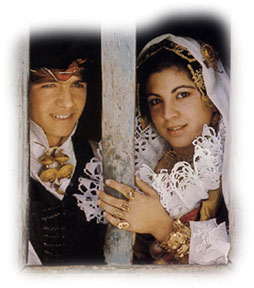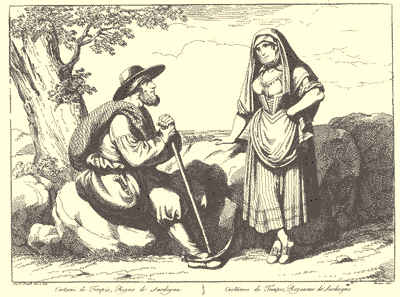This jewellery was made of gold, silver and very thin
filigree. Often the round or elongated shapes of the jewellery had sexual undertones, such as
the mammillary shaped buttons, the little bells and the pendants. The methods used to make
this jewellery are ancient and are connected to the subtle magic meaning of ancient rituals that
were evocative of life, fertility and love.
Undoubtedly the wide range of necklaces,
medallions, rings, brooches, bracelets, and other jewellery are a show within a show and an extraordinary
example of the goldsmith's art that bestows on women a special charm. |
|
 |
 |
|
The writer Paolo Orano wrote: "The
women from Nuoro have the same elegance and dignity as the Messaline" while another historian called
Valery, who spent a long time in Sardinia, wrote in 1836 "The Roman and Neapolitan country women
(peasants) so praised for their charm are not fit to be the servants to the Sardinian women when it
comes to the richness and variety of their jewellery." Very generous compliments indeed. It should
be pointed out that female costumes in the 1800s evolved remarkably compared to the more sober
costumes of the previous centuries when Sardinian women, according to some experts, used to wear
clothes exactly like the cloth that Briseide, the virtuous and faithful slave of the mythic Grecian hero
Achille, wore.
|
 |
COSTUMI DI TEMPIO - REGNO DI
SARDEGNA
Engraving in copper (29 x 21) by Bartolomeo Pinelli - 1828
(A Collection of the most Interesting Italian Costumes [Raccolta di costumi italiani i più interessanti]
Rome 1828, 50 plates without text)
This plate is particularly interesting in that it is one of only two plates of Sardinian costumes by
one of the most famous artists of the 1800s published in one of his
first "Collections of Italian Costumes".
What makes it more interesting is the fact that it is one of the first plates regarding Sardinia to
be done in the 1800s.
|
|

